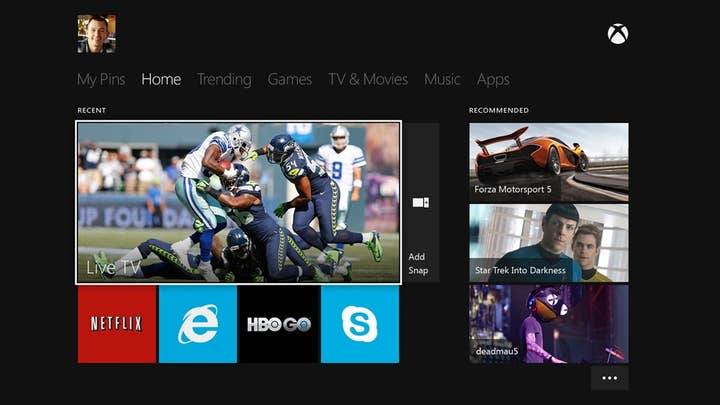Xbox One: Inside The Belly of a Trojan Horse
Jeremy Parish sees a long-term plan finally coming to fruition on the Redmond campus, but will gamers buy into this vision?
After sitting in the audience of both Sony and Microsoft's next-gen platform announcement events, almost exactly two months apart, I've been struck most profoundly by how differently the two companies have chosen to pitch devices that -- perhaps more than any console generation to date -- are so incredibly similar in tech and purpose. Both take the form of highly connected, self-contained boxes stuffed with what sounds like the sort of hardware you'd expect to find in a not-quite-top-tier gaming PC. Yet the messages surrounding PlayStation 4 and Xbox One couldn't be more different.
When Sony showed off the PS4 back in March, the company spent two hours going into unusual detail on the machine's underpinnings and even the guiding philosophy behind its hardware design. Games took center stage, with a heavy emphasis on the new ideas and methods of play consumers can expect to find on the new machine. While a lot of people came away from the PS4 reveal somewhat confused by such high-level talk -- not to mention unhappy about Sony's reluctance to show off the actual box -- the message the company sent with its approach came through loud and clear to those who listened: An apology for losing the plot during the PlayStation 3's development, and a statement of intent to make the PS4 a machine designed first and foremost for playing games.

Microsoft's presentation, on the other hand, began with Don Mattrick proclaiming, "It's time for technology to step behind the curtain," and that's exactly how it played out. Aside from a brief slide touching on a general overview of the system's specs, the discussion was much less technical than Sony's -- more like a standard E3 press conference. Much to the consternation of many fans, however, video games also ended up swept to the backstage; the Xbox One presentation barely even referenced games for the first half of its hour-long pep rally. Television, movies, Skype, and fantasy football dominated the front half of Xbox One's introduction. Only two new games were announced -- Turn10's Forza Motorsport 5 and Remedy's Quantum Break -- and even Xbox flagship franchise Halo only garnered mention in the form of the upcoming Steven Spielberg-helmed live-action premium television series.
I don't know that you can pin down either approach as right or wrong. Neither company managed to knock it out of the park across their entire audience, but that probably speaks to how video games have spread into popular culture by exploring concepts and demographics far beyond the traditional core consumer that defined the medium a decade ago. Microsoft is shooting for the A&F college jock (or the dad who wishes he still was one) while Sony has chosen to double down on the traditional core gamer.
In short, Sony is after the folks who call themselves "gamers" as a point of pride, while Xbox One -- at least so far -- looks like it's being pitched almost as a Trojan Horse for games. "Here's a system that can complement your sports-obsessed lifestyle," Microsoft has proclaimed. "And also, you can play video games on it if you want. You know, Madden, Call of Duty, that kind of thing." Case in point: Microsoft uses tablets as a second screen; PS4 uses PlayStation Vita.
"That the Xbox brand seems to have arrived at a point at which gaming is a feature rather than the centerpiece isn't a matter of Microsoft losing the plot; it's Microsoft's long-term plan finally coming to fruition"
Understandably, this has left the gaming press portions of the crowd here to see the system with a sour taste in their mouth (to say nothing of the snarky "bro" remarks being tossed around online). The general response is less the frustrated uncertainty that followed Sony's event and more a mild sense of betrayal. "I feel like Microsoft is trying to sell a game machine but is embarrassed by video games," I overheard one journalist complain.
But the idea that Xbox One has to sneak its video game functionality under the radar may be looking at the situation from the wrong direction. The Xbox One isn't a Trojan Horse to slip video games into the living room; video games were the Trojan Horse to grant Microsoft control over the living room. The idea of Microsoft taking over the family entertainment center dates back at least 15 years, back when the company seemed like some kind of unstoppable technological juggernaut, and before their involvement in console gaming had even begun to manifest as the WinCE layer in Sega's Dreamcast. That the Xbox brand seems to have arrived at a point at which gaming is a feature rather than the centerpiece isn't a matter of Microsoft losing the plot; it's Microsoft's long-term plan finally coming to fruition.
Regardless of where you think gaming should live within the Xbox ecosystem, the package presented in the form of Xbox One is quite compelling. Nothing Microsoft showed off today is entirely new and radical by any means -- PlayStation 4 is offering a lot of these same social and media features, and you can already shuffle between entertainment formats on Xbox 360 and Nintendo's Wii U. The appeal lies in the apparent seamlessness and fluidity Xbox One brings to the affair. If today's stage demo represents the final product (and one would hope it does), jumping between functions will be instantaneous; the machine can even run multiple functions in smooth, windowed environments.
In a developer roundtable, the system's hardware team discussed a lot of the technical thinking behind the One's innards -- a lot of the same ground Sony covered, but as a corollary to the main presentation rather than a prelude to it. A lot of attention was given to the system's healthy RAM specs -- nearly double what the developers feel is really necessary to simply run games. By packing in so much surplus high-speed memory, the Xbox One team has made possible simultaneous virtual machines that can switch instantly into and out of active memory. At the very least, it should be a welcome change from the agonizing 10-second transitions between system functions that Wii U users have learned to live with.
I find it interesting that Microsoft and Sony have naturally targeted different ends of the gamer spectrum. The differences aren't mere lip-service but rather part of the fundamental underpinnings of each console, their prevailing philosophies. I'll be interested to see which tactic works better. Both? Neither? Will casual gamers buy a gaming device to run their living room? Are there enough core gamers left to sustain an entire platform dedicated to them alone?
Jeremy Parish is Games Editor at USgamer. USgamer is an upcoming consumer website published by Gamer Network and launching in early June, and will be located at http://www.usgamer.net.
